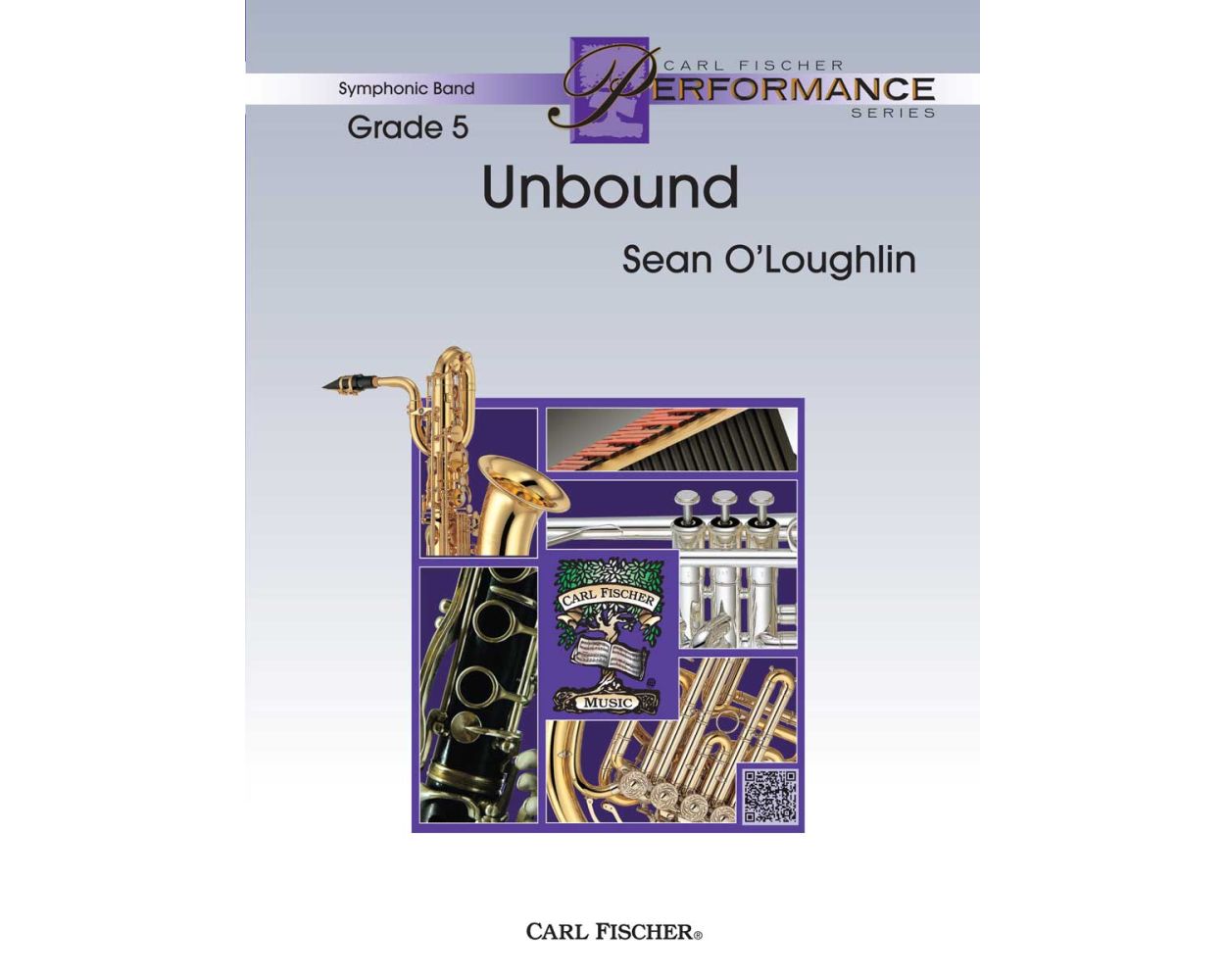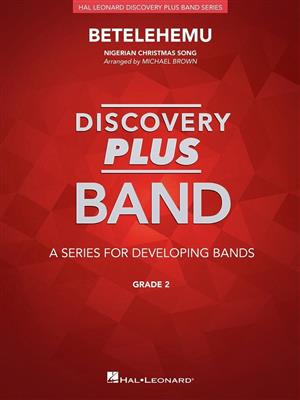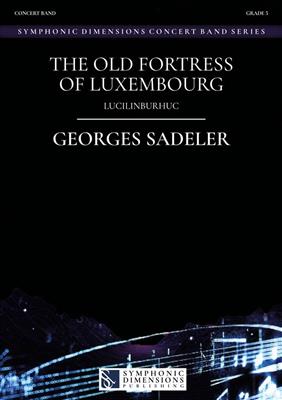Results
-
 £95.00
£95.00Unbound
Unbound is an exciting composition for the advanced ensemble. With whirlwind flourishes, rhythmic punctuations and broad melodies, the music is sure to take your audience on a a roller coaster ride. Composer Sean O'Loughlin shows off his compositional chops and brings us an intense concert opener or closer that will stir the emotions of your students and a roller coaster ride. Composer Sean O'Loughlin shows off his compositional chops and brings us an intense concert opener or closer that will stir the emotions of your students and
Estimated dispatch 12-14 working days
-
 £40.00
£40.00Flaming Arrow
Flaming Arrow is written for beginning band, and uses only the first six notes learned in most beginning band methods: Bb to G. The piece is cast in C minor; consequently, an alternate trombone part is provided that does not reach out to sixth position. Beginning with mysterious opening material that is used later in the work, the piece then moves to an aggressive up-tempo section with lots of percussion. This is followed by a return of the slow opening material and a gradual accelerando with the sound of tom-toms. The piece ends with a short coda for an energetic conclusion.
Estimated dispatch 12-14 working days
-
£29.99
Moment - Alex Shapiro
Pensive and emotional, the unusual, textural music of MOMENT offers reflection and stillness in an often frenetic world. Repeating notes and haunting, lyrical lines give musicians the opportunity to explore expression through subtlety. Evocative sounds conjure fleeting, contrasting images, as the wind band creates a seamless fabric woven from the union of their instruments, their chant-like voices, and the ghostly echoes of a wistful accompaniment soundtrack. What are the moments that have moved you? To perform the piece, you'll need an audio system capable of playing the prerecorded audio tracks from a laptop computer via a small digital audio interface connected to an audio mixer. Download information is provided in the printed piece.
Estimated dispatch 7-14 working days
-
 £79.99
£79.99Chorale for Peace - Thierry Deleruyelle
Chorale for Peace is a song of hope and peace for humanity. In commissioning this work, the wind band of Le Portel (France) wanted to pay tribute to the victims of 8 September 1943, when around 100 Allied planes dropped more than 5,000 bombs on the town of Boulogne and the surrounding area. In fact, this operation was nothing more than a diversion to make the enemy believe that a landing was imminent in the north of France. This music is slow, an adagio commemorating the human sacrifice of this operation. But more broadly, the composer also wanted to express his support for the peoples who, even today, suffer oppression. This set includes an optional choir part that offers the possibility of making an even deeper impression on the listener.
Estimated dispatch 7-14 working days
-
 £53.50
£53.50No Step, Go Step, Half Step, Whole Step! - Richard L. Saucedo
Not only is this an intriguing concert piece for 2nd year players, it's also a great way to introduce the basics of simple intervals. It's sure to be an entertaining piece for every section of the band, plus your percussionists will be fighting over who gets to play the vibraslap! (This publication includes an optional DroneMap rehearsal aid created by Michael Pote) Dur: ca. 2:45
Estimated dispatch 7-14 working days
-
 £60.99
£60.99Betelehemu
Add an international flavor to your next winter concert with Michael Brown's inventive setting of this Nigerian Christmas song. The piece opens with a beautiful slow melody accompanied by an underlying rhythmic pulse. The second half is an exuberant celebration in a faster tempo complete with African drumming and joyous full band refrains.
Estimated dispatch 7-14 working days
-
 £159.99
£159.99The old Fortress of Luxembourg - Georges Sadeler
"The Old Fortress of Luxembourg" is a commissioned work by the Luxembourg Ministry of Culture for the overture of the official ceremony of Luxembourg's National Day. The piece is less concerned with history, but rather draws inspiration from the architecture of the ancient fortress of Luxembourg, known as Lucilinburhuc."The fortress, over 1000 years old and also referred to as the "Gibraltar of the North," primarily consists today of the Bock Rock, the crypt, the casemates (an underground defense system consisting of kilometers of tunnels), and the Holy Spirit Citadel. These elements are portrayed through radiant fanfare sounds, rhythmic orchestral movements, patriotic choral melodies, and at times, somber musical depictions.As an optional highlight, a choir, supported by a boys' choir, interprets the newly composed text of the third verse of the Luxembourgish National Anthem, adding an additional touch of patriotic grandeur to this piece.
Estimated dispatch 7-14 working days
-
 £229.99
£229.99Fragments - Georges Sadeler
The work "Fragments" is an extremely powerful and energetic Concertino for trombone, full of different tonal colours and based on two motifs that are broken down into their fragments and processed further. The slightly playful main motif is presented by the soloist after an imposing introduction and gradually develops jazzy elements without abandoning the contemporary spirit. Throughout the work, the last three notes of the introductory motif are presented both as a short, shrill fragment and as a lyrical theme, which supports the constant alternation between leggero and marcato. An ostinato, which is carried through all registers, gives the work the necessary drift and serves as a common thread to connect the different parts."Fragments" was commissioned by the Luxembourg Ministry of Culture in collaboration with the "De klenge Maarnicher Festival" and was a compulsory piece for the final round of the "1st Michel Becquet International Trombone Competition".
Estimated dispatch 7-14 working days
-
 £62.95
£62.95Battle Cry - Brian Beck
Battle Cry, by Brian Beck, is an intense and exciting piece for musicians who are not afraid of a fight. The many shifts in style, dynamic markings, and various accidentals in every part help provide a rich harmonic and melodic contrast. Each part's range is very conservative, allowing even the youngest musicians an opportunity for an impressive performance. (2:40) (Correlates to Sound Innovations, Book 2, Level 4).
Estimated dispatch 7-14 working days
-
 £159.99
£159.99Resurrection - Kevin Houben
"Man wird mit Keulen zu Boden geschlagen und dann auf Engelsfittichen zu den hchsten Hhen gehoben." (Mahler over zijn 2de symfonie "Wederopstanding", Juli 1894)*"You are clubbed to the ground and then lifted to the highest heights on angels' wings"Commissioned by and dedicated to Concertband Maasmechelen (BE), conducted by Mark Prils.Kevin Houben was inspired for this work by Gustav Mahler's 2nd symphony, better known as the Resurrection symphony.The work can be regarded as a Ma(h)lerei of various compositional and spherical elements that refer to the Austrian composer but that appear in this composition in an embedded, contemporary way.As Mahler often drew his inspiration from nature, the opening of this piece brings nature right to the audience. The work starts with a solo for alto flute accompanied by a pedal note in four octaves with harmonic responses echoing the solo.From the start, Kevin Houben provides Mahler's material with a contemporary touch. He replaces the nature sounds that Mahler uses (perfect fourth) with tritone intervals. The off stage trumpet signals have been preserved but are provided with a new accompaniment. Gradually, throughout the work, the orchestra undergoes its own independent development. Mahler's musical signature remains recognizable, but Kevin Houben allows it - e.g. through the use of various timbres - to flourish in a more modern musical idiom, which characterizes numerous contemporary compositions for wind band (cfr. Where Angels Fly).The work comes to a grandiose end with a passage of the famous chorale from Mahler's 2nd symphony. The rich orchestration of this chorale gives the listener the illusion of the presence of a choir and organ without actually using them.In Resurrection, each instrument group comes into its own: in solo fragments, in transparent thematic passages or in splendid tuttis. Therefore, the work forms an interesting challenge for a wind band on several levels, both technically and melodically - the latter due to the long suspenseful melodic phrases that the musical structure requires.The piece is accessible to a wide audience and can be regarded as an enrichment for any concert programme. Resurrection takes the audience through various atmospheres and experiences: from stunning to chilling, from calming to delighting...Die Musik muss immer ein Sehnen enthalten, ein Sehnen ber die Dinge dieser Welt hinaus." (Gustav Mahler, 1860-1911)"Music must always involve a longing, a yearning beyond the things of this world."
Estimated dispatch 7-14 working days
